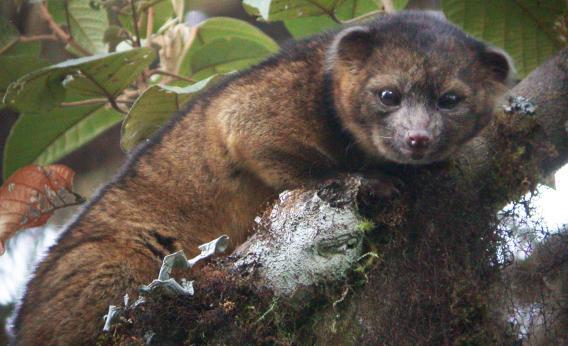It used to be, explorers went trekking through the wilderness in search of new species (and gold, monsters, magical fountains, etc.). Imagine what it was to be the naturalist on Captain Cook’s ship. “Uh, there’s one. And another one over there. Hey, there’s a new species eating another new species while a third new species watches. Which one do you want to eat for dinner, Captain?” Of course, governments nowadays are less likely to sponsor such exploratory assays, and much of the planet is pretty well-covered territory by now. Which means one of the best methods scientists have for finding new species is to go into a museum and pluck one off the rack.
Back in 2003, Kristofer Helgen, curator of mammals at the Smithsonian National Museum of Natural History, started picking through the skin and bones of some olingos, these weird little arboreal beasts from Central and South America. But something didn’t seem right. Olingos are grayish, and some of the pelts he was pulling out of the Chicago Field Museum were decidedly reddish brown. “They stopped me in my tracks,” he told Smithsonian magazine. And “stopped” is probably where he would have stayed if it weren’t for modern technology.
By wielding Thor’s hammer of scientific divining (more commonly known as DNA analysis), Helgen cleaved a branch of the Tree of Life in two. Analysis revealed that the olingo and this new red thing shared just 90 percent of their DNA, which in DNA-terms represents an enormous gap. (Remember that humans, chimps, and bonobos share 99 percent.) A creature that had spent decades in a drawer labeled olingo would now be born anew as olinguito! (Pronounced oh-lin-GHEE-toe.)
You may be thinking, “Oh, how the world will tremble in the wake of this new, slightly smaller and redder nocturnal carnivore!” But it is a pretty big deal. Scientists haven’t discovered a carnivore in the Americas since the semiaquatic Colombian weasel 35 years ago. (Somewhere, a Colombian weasel is reading this and seething with the acute pain known only to grown-up child actors and one-hit wonders.) Even more amazing, the olinguito isn’t simply biding its time until extinction on some sinking island or disappearing ecosystem. I mean, yes, the rainforests of South America are disappearing at an alarming rate, but so far it seems the olinguitos may exist in the thousands in Ecuador and Colombia. Heck, they are enough of them at least for Helgen to have identified four different olinguito subspecies.
So, how does a 2-pound, 14-inch fur ball that looks like a cross between a teddy bear and a Tanooki Suit elude the prying eyes of hunters and naturalists until 2013?* (Side note: PETA is very much against Mario wearing a Tanooki Suit, because it supposedly promotes the fur trade of an actual species, the Japanese raccoon dog or tanuki.) Well, the first thing is that olinguitos hardly ever come down out of the trees. Moreover, they’re nocturnal, and the “clouds” that give cloud forests their name make it really difficult to see into the canopy.
And clearly there’s the bit about mistaken identity. Helgen based his assumption that olinguitos were a new species on skulls and skins, but he had to wrangle a team of scientists into Ecuador to track down a living specimen in order to do the DNA analysis. (Because of the aforementioned issues with finding olinguitos, a local hunter helped them finally shoot and retrieve the elusive critter. The Smithsonian assures us this was a “last-resort move among field biologists.”)
Oh, and get this: Helgen thinks an olinguito might have toured the zoo circuit in the 1960s, though as was the case with the museum specimens, the creature was misidentified as an olingo. No wonder the little bugger wouldn’t breed.
Discoveries like the olinguito bear even greater importance when you consider something like 10,000 species go extinct every year. Logging, agriculture, pollution, development, and climate change—it’s clear humanity’s impact on the planet marches much faster than most species can adapt. We’re less and less likely to encounter these new species in the wild, despite the enormous diversity yet to be identified. As Chris Norris of the Peabody Museum of Natural History told the BBC, “The vast majority of the discoveries of new species are made in museum collections.”
The good news here, of course, is that this means there are still all kinds of crazy-sexy-cool creatures lurking in the world’s museum drawers. Even better, there’s a YouTube channel run by Emily Graslie of the Chicago Field Museum—yes, the very same museum in which Helgen began his search!—that digs through these drawers with equal parts levity and science. May I suggest you start with the pangolin?
Correction, Aug. 16, 2013: This sentence originally included the wrong year in which the olinguito discovery was announced. It was of course 2013, not 2014.
